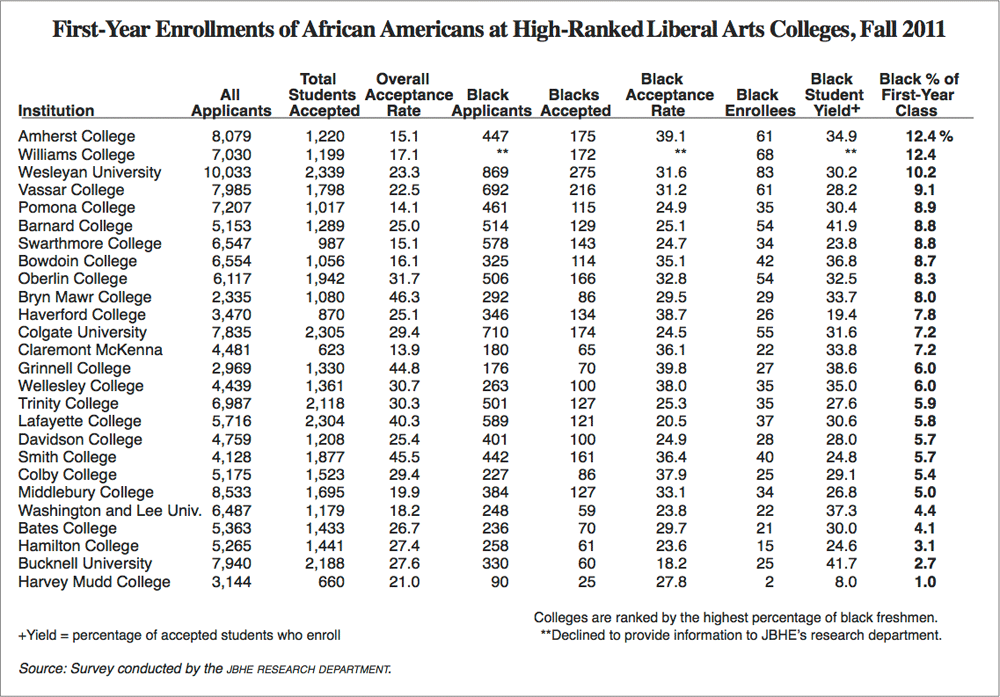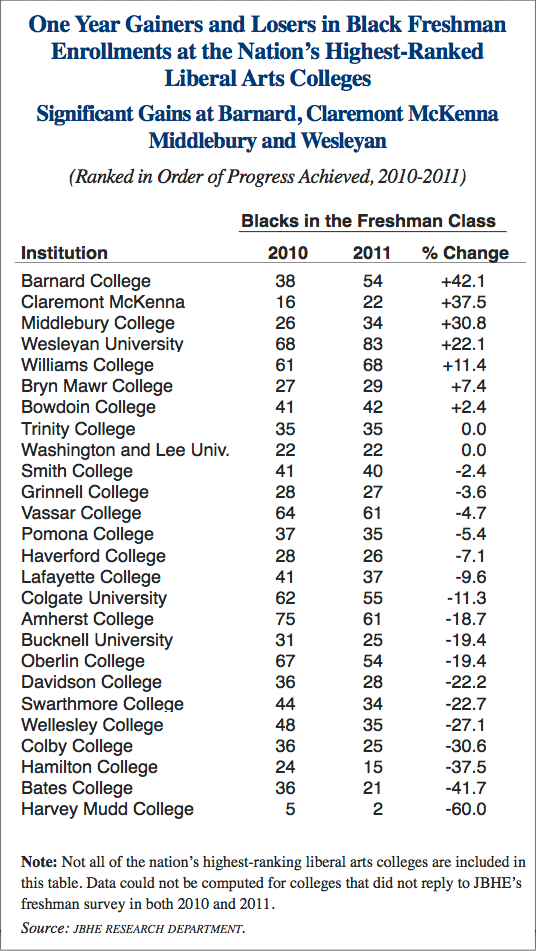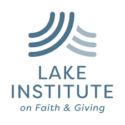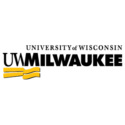For 18 years JBHE has collected black student admissions data on the highest-ranked liberal arts colleges. Over this long period, there have been seven years when Amherst College reported the highest percentage of black freshmen. On five occasions Wesleyan University in Middletown, Connecticut, had enrolled the highest percentage of black first-year students.
This year, Amherst leads the rankings for the fifth consecutive year. There are 61 black freshmen at Amherst College, making up 12.4 percent of the entering class. Amherst maintained its top ranking from a year ago despite the fact that the number of black freshmen at the college is lower than in 2010.
In a tie with Amherst for first place is Williams College in Williamstown, Massachusetts. There are 68 black students in the entering class at Williams this year and they make up 12.4 percent of all freshmen. Williams was in fourth place a year ago but saw an 11.4 increase in black freshmen this year.
Wesleyan University, which as stated, has led our ranking on five occasions had slipped in the standings for several years. But this year Wesleyan is back near the top. There are 83 black freshmen at the college this year, up more than 22 percent from a year ago. Blacks make up 10.2 percent of the entering class at Wesleyan.
Vassar College moved up from fifth place a year ago to the fourth position this year. This occurred despite the fact that the number and percentage of blacks in the first-year class declined slightly.
Pomona College in California which has finished as high as second among the liberal arts colleges in our survey, is in fifth place this year. There are 35 blacks in the entering class and they make up 8.9 percent of all first-year students.
Barnard College in New York City ranks in sixth place. There was a huge increase in black entering students this year at Barnard compared to a year ago. In 2010 there were 38 blacks in the first-year class. This fall there are 54, an increase of 42.1 percent. That is the largest one-year percentage increase of black students in this year’s survey of liberal arts colleges.
In recent years black freshman enrollments at Swarthmore have been on a roller-coaster ride with a high of 43 in 2006 and a low of 18 in 2001. This year, there are 34 black freshmen at Swarthmore, making up 8.8 percent of the incoming students. This places Swarthmore in a tie for sixth place with Barnard.
Bowdoin, Oberlin and Bryn Mawr finish out the top 10 in our rankings. All other liberal arts colleges in our survey had freshman classes where blacks were less than 8 percent of incoming students.

Liberal Arts Colleges: Short-Term Gainers and Losers
Now we turn to a comparison of this year’s results with the data from last year. For the 26 colleges for which we have data, only seven colleges posted gains over last year in black enrollments. As stated earlier, Barnard posted the largest gain. Other liberal arts college posting increases in black freshmen this year are Claremont McKenna, Middlebury, Wesleyan, Williams, Bryn Mawr, and Bowdoin. Last year, 16 of these high-ranked liberal arts schools posts gains in entering black students.
High-ranking liberal arts colleges showing significant declines in black freshmen are Harvey Mudd College, Bates College, Hamilton College, Colby College, and Wellesley College.

Black Acceptance Rates at Liberal Arts Colleges
This year we have acceptance rate data for all but one of the high-ranking liberal arts colleges in our survey. Only Williams College declined to release information on the college’s black student acceptance rate.
At 16 of the 25 high-ranking liberal arts colleges for which we have data, the black acceptance rate was higher than the acceptance rate for nonblack applicants. In some cases the differences were very large. For example, at Amherst College 39.1 percent of black applicants were admitted compared to 15.1 percent of all applicants to the college. At Bowdoin, the black acceptance rate of 35.1 percent is also more than double the rate for all Bowdoin students, which stood at 16.1 percent.
At Bryn Mawr, Colgate, Trinity, Lafayette, Davidson, Smith, Hamilton, and Bucknell, the black student acceptance rate was below the rate prevailing for all students.
The highest black student yield among the leading liberal arts colleges in our survey belongs to Barnard College. Fifty-four of the 129 black students accepted at the university decided to enroll. The only other high-ranking liberal arts college with a black student yield of more than 40 percent is Bucknell University in Lewisburg, Pennsylvania. Black student yield at Bucknell was 41.7 percent this year. Washington and Lee University in Lexington, Virginia, had the third-highest black student yield at 37.3 percent among the top liberal arts colleges.











Affirmative Action At Work:
“At 16 of the 25 high-ranking liberal arts colleges for which we have data, the black acceptance rate was higher than the acceptance rate for nonblack applicants.”
There are are Blacks who have credentials that exceed non Blacks. Perhaps, just perhaps, it was not affirmative action, rather excellent credentials that made the difference in the rate of acceptance.
Thanks for the years of tracking some of our kids.
I am out of touch with what’s happening at top-notch liberal arts colleges like my alma mater, Oberlin College. Coming from the housing projects of White Plains NY, I got to go to Oberlin on several scholarships and work-study jobs. While I wonder how we are doing overall, the survey, to me, says there remains a generation of highly-educated Blacks going to schools offering a liberal arts education. That’s good. I have loved teaching in an urban community college where my students mostly come under-prepared from the public school system, but they come. That’s good.
Can’t remember the name of a recent book that presents Black America as four very different socio-economic groups who have little contact with each other. That’s true. Anybody know the name of the book? Thanks again JBHE.
The book is Disintegration: The Splintering of Black America by Eugene Robinson.
Dear Editors,
Your annual survey has been very useful as I help my son identify good colleges to apply to where he has a chance of getting in, but also “fitting” in. (As another article on your site notes, some campuses feel less integrated or welcoming than others.) One thing I have not seen covered and I don’t know if it’s available, is GPA of black students admitted to highly ranked liberal arts colleges. Are the black students getting into Amherst or Middlebury, for example, mostly 4.0 students? I recently met someone whose 3.8 GPA son with a great resume of activities and awards was turned down by all Ivies, but accepted into several of the top liberal arts colleges that you mention. Are these liberal arts schools accepting only the super-accomplished black student?
Thank you.
Generally the Ivies have lower rates of acceptances than the leading liberal arts colleges. Generally schools are tight-lipped about the academic qualifications of the Black students they admit. But GPAs can also be misleading because grading is subjective and differs from school to school. But Black students admitted to all these schools generally are high achievers.